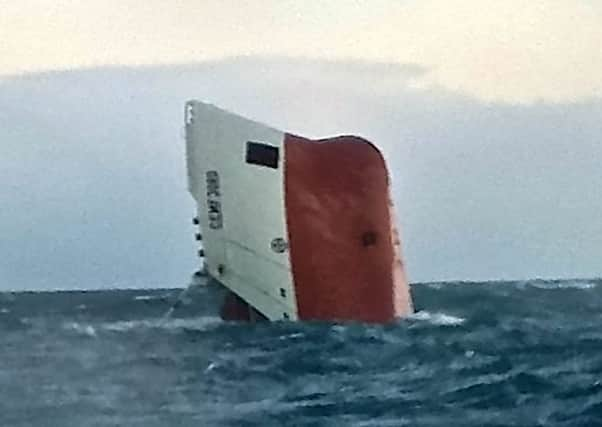Sunken cargo ship off Orkney '˜pressured' to complete journey


A Marine Accident Investigation Branch (MAIB) review concluded the deaths of the eight Polish and Filipino crew onboard the Cemfjord could have been avoided.
The upturned hull of the Cypriot-registered cement carrier was spotted in the Pentland Firth by a passing ferry on 3 January 2015.
Advertisement
Hide AdAdvertisement
Hide AdIt had been travelling from Aalborg, Denmark, to Runcorn, Cheshire, but capsized so quickly on January 2 in “extraordinarily violent sea conditions” that the crew did not have time to issue a distress call.
An extensive coastguard search followed but none of the crew were found. The ship remains at the bottom of the Pentland Firth as a sea grave.
The MAIB investigation highlights a series of failings in the planning of the Cemfjord’s voyage, pressure to complete the journey and “significant safety deficiencies relating to its rescue boat launching arrangements and bilge pumping system”.
The capsize went unnoticed for a day because Cemfjord’s progress through the Pentland Firth was not being monitored and Shetland Coastguard did not require vessels to report when exiting the voluntary reporting scheme area, MAIB said.
The vessel’s managing company, Brise, has implemented safety changes since the accident, including enhancements to stability and weather forecasting on ships.
Steve Clinch, chief inspector of marine accidents, said: “The MAIB investigation found that Cemfjord capsized in extraordinarily violent sea conditions; a fatal hazard that was predictable and could have been avoided.
“The decision to enter the Pentland Firth, rather than seek shelter, was almost certainly a result of poor passage planning, an underestimation of the severity of the conditions and perceived or actual commercial pressure to press ahead with the voyage.
“Critically, this decision will also have been underpinned by an unwillingness to alter course across the heavy seas after the experience of a cement cargo shift in similar circumstances about three months before the accident.
Advertisement
Hide AdAdvertisement
Hide Ad“The appalling conditions and rapid nature of the capsize denied the crew an opportunity to issue a distress message or to escape from their ship.
“Although not a causal factor of the accident, it was also established that Cemfjord was only at sea because of flag state-approved exemptions from safety regulations.
“This tragic accident is a stark reminder of the hazards faced by mariners at sea and the factors that can influence decision making in such treacherous circumstances.”
Brise said it has held an internal investigation which came to similar conclusions.
The company said the master of any Brise ship has “full discretion” to take whatever decisions are necessary to secure its safety and any commercial pressures would come from chartering companies rather that the ship owners.
A company spokesman said: “At this time, we wish to express once again our condolences to the families of those who lost their lives.
“The background to this accident is complex but the MAIB report and the company’s own investigations have done much to clarify a series of important issues.
“Both investigations reach an identical conclusion.”